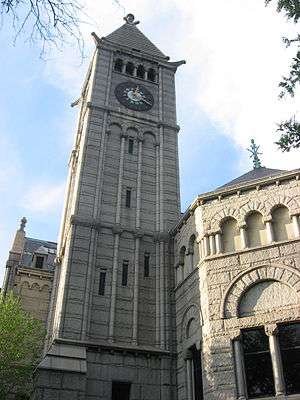Carnegie Free Library of Allegheny
|
Carnegie Free Library of Allegheny | |
 | |
   | |
| Location | Allegheny Center, Pittsburgh, Pennsylvania |
|---|---|
| Coordinates | 40°27′11″N 80°0′19″W / 40.45306°N 80.00528°WCoordinates: 40°27′11″N 80°0′19″W / 40.45306°N 80.00528°W |
| Area | 1 acre (0.40 ha) |
| Built | 1886–90 |
| Architect | Smithmeyer & Pelz |
| Architectural style | Romanesque Revival, Richardsonian Romanesque |
| NRHP Reference # | 74001736[1] |
| Significant dates | |
| Added to NRHP | November 1, 1974 |
| Designated CPHS | March 15, 1974[2] |
| Designated PHLF | 1970[3] |
The Carnegie Free Library of Allegheny is situated in the Allegheny Center neighborhood of Pittsburgh, Pennsylvania. Donated to the public by entrepreneur Andrew Carnegie, it was built from 1886 to 1890 on a design by John L. Smithmeyer and Paul J. Pelz.
It was commissioned in 1886, the first Carnegie library to be commissioned in the United States. Yet it did not open until 1890 thus making it the second library to open. The first one to open being the Carnegie Free Library of Braddock, built for steel-workers in Braddock, 9 miles up the Monongahela River from Pittsburgh.
The building also features the first Carnegie Music Hall in the United States. The Music Hall at the Braddock Library would not open until an 1893 expansion of that structure.
The running costs were met from local taxes – unlike the Carnegie Library in Braddock, which received an endowment from Carnegie.[4] After a mid-2000s lightning strike, the library was moved to a new building a few blocks north on Federal Street. The New Hazlett Theater is now the primary tenant. It was listed on the National Register of Historic Places in 1974.[1]
Gallery
 Reading Room, ca. 1900
Reading Room, ca. 1900 Women's Reading Room, ca. 1900
Women's Reading Room, ca. 1900 Library entrance
Library entrance Carnegie Hall entrance (now New Hazlett Theater)
Carnegie Hall entrance (now New Hazlett Theater) Monument to Colonel James Anderson, who inspired Carnegie to donate free libraries
Monument to Colonel James Anderson, who inspired Carnegie to donate free libraries
References
- 1 2 National Park Service (2009-03-13). "National Register Information System". National Register of Historic Places. National Park Service.
- ↑ "Local Historic Designations". Pittsburgh, PA: Pittsburgh History & Landmarks Foundation. Retrieved 2010-07-10.
- ↑ Historic Landmark Plaques 1968–2009 (PDF). Pittsburgh, PA: Pittsburgh History & Landmarks Foundation. 2010. Retrieved 2010-07-02.
- ↑

